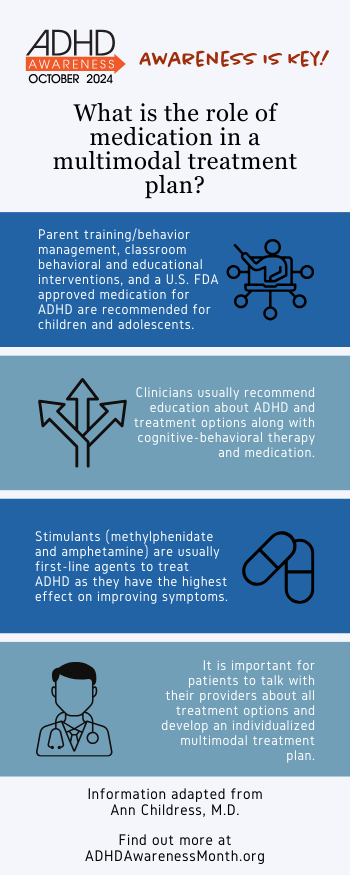Guidelines from the American Academy of Pediatrics recommend parent training/behavioral management along with classroom behavioral and educational interventions, as appropriate, and a FDA-approved medication for ADHD. Although there are currently no U.S. guidelines for the evaluation and treatment of ADHD in adults, clinicians usually recommend education about ADHD and treatment options along with cognitive-behavioral therapy and medication.

The American Academy of Pediatrics Clinical Practice Guidelines for the Diagnosis, Evaluation and Treatment of Attention-Deficit/Hyperactivity Disorder (ADHD) in Children and Adolescents recommend parent training /behavior management along with classroom behavioral and educational interventions, as appropriate, and a U.S. Food and Drug Administration (FDA) approved medication for ADHD. FDA-approved medications include stimulants (amphetamine and methylphenidate) and nonstimulants (guanfacine extended-release, clonidine extended-release, viloxazine extended-release, and atomoxetine).
There are currently no U.S. guidelines for the evaluation and treatment of ADHD in adults. However, clinicians usually recommend education about ADHD and treatment options along with cognitive-behavioral therapy and medication.
Stimulants (methylphenidate and amphetamine) are usually first-line agents to treat ADHD because have the highest effect on improving ADHD symptoms. However, patients may prefer to start with a nonstimulant as they are not controlled (not addictive) substances. Although methylphenidate and amphetamine do have the potential for misuse, patients with ADHD are less likely to misuse these medications when treated properly than those with ADHD who do not receive treatment. Other reasons to start a nonstimulant include concerns about side effects—for example, in children, stimulants can cause slowing of growth not found in patients treated with nonstimulants.
Another factor influencing medication choice during the past two years has been a shortage of available stimulant medication. The limited supply has largely impacted generic stimulants. Although brand medications are available, many insurance companies will not cover brand-name medications and patients are often unable to afford them.
It is important for patients to talk with their providers about all treatment options and develop a multimodal treatment plan to meet their individual needs. Medication availability also needs to be part of the conversation.
Read more in this Article Link.
About the Author

Ann Childress, MD, is a child, adolescent, and adult psychiatrist. She is a Past President of the American Professional Society of ADHD and related disorders. Dr. Childress has authored more than 100 publications on ADHD and completed more than 200 clinical trials as a principal investigator.
